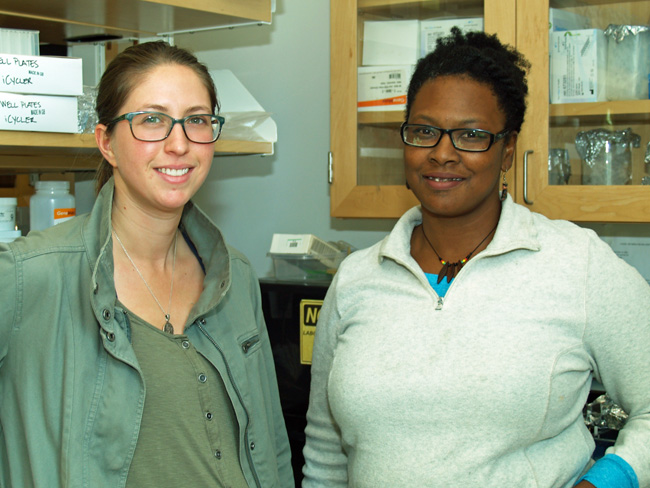Two graduate students who conducted their research at UGA Skidaway Institute of Oceanography successfully defended their theses this fall and are scheduled to receive their master’s degrees in December.

Christine Burns (l) and Tina Walters
Tina Walters is a full-time laboratory manager for Skidaway Institute researcher Marc Frischer, and has been attending graduate school at Savannah State University on a part-time basis for several years. Her thesis, is titled “Molecular gut profiling of Dolioletta gegenbauri in the South Atlantic Bight continental shelf: What are they eating?” A chapter of the paper will be published in the journal, “Molecular Ecology, Special issue: Species Interactions, Ecological Networks and Community Dynamics.”
“The overall focus of my research was to determine the role of doliolids in the food web,” Walters said. “What do doliolids eat, and who eats them? My thesis focused on what they are eating out there in nature. I used DNA-based methods to answer that question.”
Walters earned an undergraduate degree in chemistry with a minor in physics from Armstrong Atlantic State University (now Georgia Southern University). She landed an internship at Skidaway Institute during her senior year and stayed on as a research technician after graduation.
Walters credits her advisor, Marc Frischer, for encouraging her on her journey.
“Dr. Frischer always encouraged me to pursue a master’s degree, especially with having the experience of being a lab technician,” she said. “It was time for me to start thinking like a scientist and further understand why the research that we are conducting is so important.”
Walters was also advised by former UGA Skidaway Institute professor Jens Nejstgaard, and professor Carol Pride, chair of the Department of Marine and Environmental Sciences at Savannah State University.
Christine Burns is a graduate student in the UGA Department of Marine Sciences. Her thesis is titled “Historical analysis of 70 years of salt marsh change at three LTER sites.”
“I am using historical aerial imagery and charts to measure long-term changes in the saltmarsh,” Burns said. “Specifically, I’m looking at changes in the area and location of channels, ponds, interior mud flats and upland islands.
“This lets us know how these different marshes change over time and helps us to better understand how stressors such as human modifications and sea level rise influence these really important ecosystems.”
Burns studied sites that are part of the Long Term Ecological Research Network, spanning a range from Georgia to Massachusetts.
“I really enjoy mapping and using GIS,” Burns said. “This project takes my background and interest in salt marshes and pairs it with my love of maps.”
From Skidaway Island, Burns will head to Washington, D.C. She has been selected for a prestigious Knauss Fellowship and will work in the NOAA Office of Coast Survey as the Precision Navigation Fellow.
Burns was advised by UGA Skidaway Institute director Clark Alexander and UGA Department of Marine Sciences professor Merryl Alber, who is also the director of the UGA Marine Institute on Sapelo Island.


